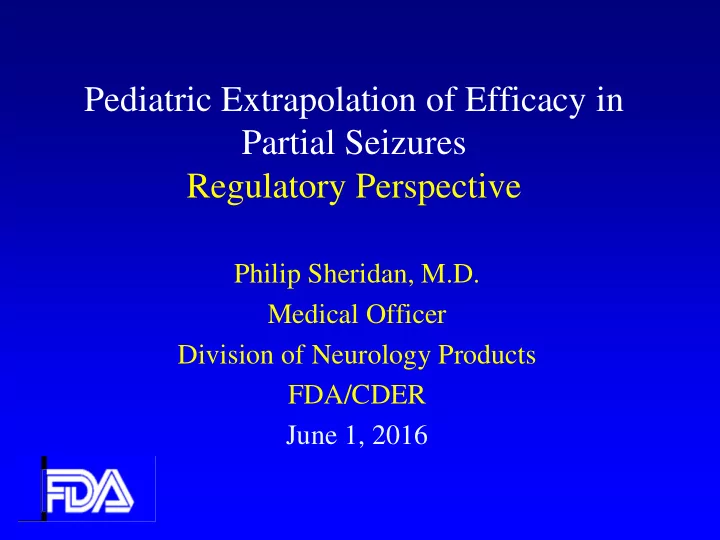

Pediatric Extrapolation of Efficacy in Partial Seizures Regulatory Perspective Philip Sheridan, M.D. Medical Officer Division of Neurology Products FDA/CDER June 1, 2016
Disclaimer • The views expressed in this presentation do not necessarily represent the policies of the Food and Drug Administration or the Department of Health and Human Services. • Philip Sheridan has no financial conflicts of interest to disclose. 2
Extrapolation of Efficacy from Adults to Children FDA may extrapolate pediatric effectiveness from adults if the following is established: – Similar pathophysiology and disease course in children and adults – Evidence that adults and children have a sufficiently similar exposure-response relationship 3
PEACE initiative • Extrapolation of efficacy from adults to pediatric patients for adjunctive therapy of partial onset seizures (POS) in patients 4 years and older is justifiable based upon our understanding of the disease process and upon exposure- response analysis. • Office of Clinical Pharmacology (OCP), in consultation with the Division of Neurology Products (DNP), performed careful exposure-response analyses that compared pediatric patients to adult patients. 4
Pediatric Extrapolation Efficacy might be extrapolated from adults to children but not pharmacokinetics (PK) and safety 5
With the understanding of similar pathophysiology and exposure-response, the following is still required for a pediatric indication for treatment of POS : • Approved indication for the treatment of POS in adults. • A pharmacokinetic analysis to determine the dosing regimen that provides similar drug exposure (at levels demonstrated to be effective in adults) in pediatric patients 4 years of age and older compared to adult patients with POS. This analysis will require pharmacokinetic data from both the adult and pediatric (4 years of age and older) populations. • Long-term open-label safety study(ies) in pediatric patients 4 years of age and older. 6
Pediatric Safety Studies • Safety from adults may provide some information, but it is not definitive for pediatric population • Safety should be assessed in pediatric population with condition of interest 7
Short-term Safety from Placebo- Controlled Study • If efficacy extrapolation is accepted, there will be no pediatric placebo-controlled efficacy and safety trial • A placebo comparator arm helps to distinguish AEs attributable to the test drug from AEs attributable to background rate, concomitant drugs, or the underlying seizure disorder. • Safety from adult studies may provide some information • Experience to date suggests that short-term AEs in the pediatric patient population are generally similar to those detected in the adult studies 8
Long-term Safety from Adult and Pediatric Open Label Studies We require an adequate amount of long- term open label safety experience in both adult and pediatric patients (age 4 years and older) with partial seizures. 9
Recommend
More recommend